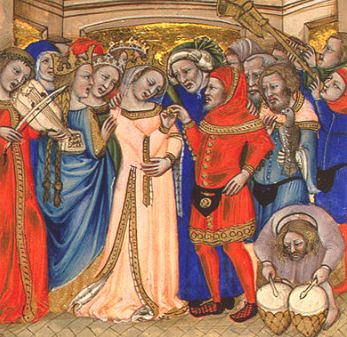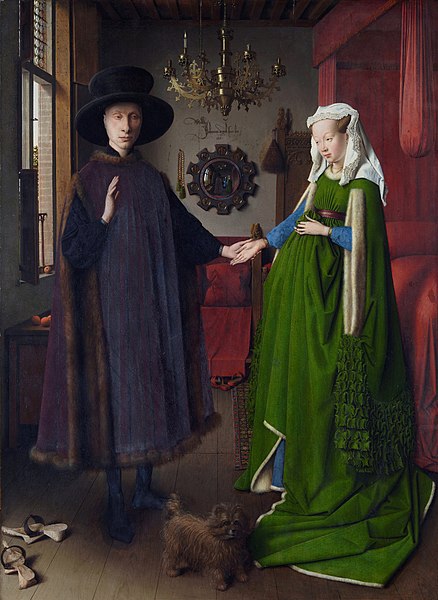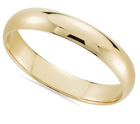 The Middle Ages were a strange, catchy, and rather frightening period in history. The same we can say about medieval wedding traditions. 5-year-old children getting wed, marriage consummations with eye-witnesses, the right of the first night, the impossibility of divorces, weird and improper wedding rituals – these are only a few things that were pretty common in medieval society. At the same time, this is the period when official marriage became sacred and many modern wedding rituals and traditions first appeared. So, this curious era deserves being studied and talked about.
The Middle Ages were a strange, catchy, and rather frightening period in history. The same we can say about medieval wedding traditions. 5-year-old children getting wed, marriage consummations with eye-witnesses, the right of the first night, the impossibility of divorces, weird and improper wedding rituals – these are only a few things that were pretty common in medieval society. At the same time, this is the period when official marriage became sacred and many modern wedding rituals and traditions first appeared. So, this curious era deserves being studied and talked about.
In the early medieval period, religion influenced marriages only slightly. Some couples already had church weddings but they weren’t as common or obligatory as they became later.
During this era, a lot of brides and grooms didn’t have any marriage ceremony at all. They could just give each other a wedding vow – and they were considered married. This promise could be given anywhere, even in a pub, in the street, or in bed. No records were done, no witnesses were needed. Of course, this sometimes caused problems when one of them claimed that it never happened – the other partner simply didn’t have any proof. And treacherous men or even women took advantage of it, having relationships with multiple partners or using a partner and leaving him/her.
Much easier the situation was with royals – these marriages were often arranged long in advance and pompous weddings were organized to celebrate a union between two royals. Medieval royal weddings usually grew into coronations and the forming of alliances.

The Marriage, miniature by Niccolò da Bologna, 1350s. It is stored in National Gallery of Art, Washington DC, the US
For the royal people, marriage was also important because their heirs had to be legitimate to inherit a throne. Still, there were so many illegitimate offspring, some of which even tried to claim their inheritance, especially if there were no legitimate heirs, that in the 13th century, the Catholic church decided to step in and make the royal marriages official. The priests made the act of marriage a sacred thing and started making records of the marriages. The church dictated that sex and childbearing without the blessing of God (meaning the official church wedding ceremony) was a sin.
In medieval Europe, most marriages were arranged and it was common for the bride and groom to see each other for the first time on their wedding day. As people lived short lives in the Middle Age period, parents often made arrangements early on and a few months old babies could be betrothed. Marriages between little children, younger than 10 years old, were not unheard of among the royals. Such marriages were made to create alliances and increase the wealth of the family. Though, such young brides and grooms didn’t perform marital duties, of course. They were raised in the royal nursery or by the court members until they were mature enough, which was around shocking 12-14 years old.
Dowry was an important part of any medieval wedding, whether it was a peasant or royal wedding. The bride’s parents had to give dowry to the groom’s family. The richness of the dowry depended on the wealth of the family.
Medieval wedding ceremony
What did a medieval marriage ceremony include? Basically, European weddings in the Middle Ages were very similar to our modern Western-style ceremonies. First of all, long before the actual wedding, so-called banns were called – on three Sundays, the couple’s intention to marry was publicly announced. It was done so that people could find out about the celebration and come to the wedding, but also, those who had objections had the opportunity to voice them. For example, if the bride or groom-to-be already was married, the spouse could make themselves known.
A wedding ceremony could not be held on Catholic holidays and on Sundays.
Before the marriage ceremony, the bride and the groom both had a thorough wash and prepared their bodies for the wedding and the intimacy of the wedding night.
The peasants didn’t have any special wedding attire – it was too expensive to buy clothing for only one occasion. But they wore the best, cleanest, and most ornate garments they owned. While the royal brides and grooms sometimes spent fortunes on their wedding outfits, which often were a part of their dowry. These wedding garments were costly and richly embellished. And, of course, they wore splendid crowns adorned with precious stones, pearls, etc.
Medieval peasant brides usually wore wedding veils. At the time, most women used veils, wimples, and other headdresses to cover their heads, so a bridal veil wasn’t something out of the ordinary. Though, another option for a bride was a floral wreath worn over loose hair.

The Arnolfini Portrait by Jan van Eyck, 1434. It is stored in National Gallery, London, the UK
The wedding ceremonies of ordinary people were simpler and less populous, obviously. The royal marriage celebrations could be huge. The royal brides and grooms were escorted to the church by the respective families, creating large processions. And they exchanged their wedding vows on a doorstep of the church, before the priest and the guests.
After that, the groom presented his bride with a wedding ring. It was blessed by the priest. And this ring was placed by the groom on each finger of the bride while he recited a certain phrase in Latin. With the “Amen!”, it, at last, reached the ring finger and stayed there. By the way, women wore their wedding rings on the right hand.
Then, the procession went into the church and a special mass began. People prayed for the couple and their future offspring.
After the mass, the priest kissed the groom on both cheeks, and the groom kissed the bride.
Medieval wedding reception
So, the couple is officially wed by the Catholic ceremony. And now, it’s time for a feast. The peasant couples celebrated with their friends and family, drinking special bridal ale (brewed for this occasion) and eating a meal. By the way, it was traditional for the wedding guests to bring some food to the reception to help feed everybody. It was more of a joint community’s dinner than a reception held by the bride and groom.
The royal wedding meal was much more festive and grand. The main feast was for the high-class gusts, but the peasants also got some treats, like wine in public fountains or food for everybody in the streets, etc. Also, parades and other celebrations for the whole community could be held.
After the reception, the couple was ushered to a chamber to consummate the marriage in bed. The royal wedding night was often observed by witnesses, including the priest or other clergy. The bride needed to be a virgin at the time, which had to be proved by the bedsheet.
There was a curious medieval wedding tradition when unmarried guests from the procession that followed the royal newlyweds to bed took turns throwing the bride and groom’s stockings at them. Who managed to make a direct hit, would presumably get married soon.
The peasant couples were luckier and usually didn’t have witnesses during their first night together. Though, there was one awful wedding tradition that dictated the “right of the first night”, which meant that a local ruler could be the one to sleep with a bride on her wedding night before the groom. Some historians say that it’s a myth and there was no such thing as the right of the first night, others claim that it’s known for a fact to happen in medieval Europe.
Divorces were a very rare thing in the Middle Ages. Only in some cases, the high clergy could give permission to divorce. And this option was available mostly for the royals and wealthy people. Ordinary peasants married once and lived together until death did them apart.


Comments